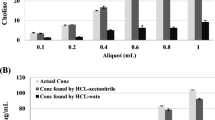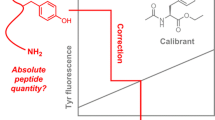Abstract
It has been possible to perform the simultaneous determination of choline and glucose using the intrinsic fluorescence of the corresponding enzyme as an analytical signal. This can be done in two ways. First, for low glucose and choline concentrations (about 0.55 mM and 0.75 µM respectively) two differentiated signals, without mutual interference, are obtained for both analytes in the same measurement. Second, when glucose and choline concentrations are higher, a new model has been designed which permits the concentrations to be accurately determined in samples containing from 0.55 mM to 3.75 mM glucose and from 0.75 µM to 11.0 µM choline; the method has been applied to simultaneous glucose and choline determinations in serum samples with good results. This method gives a better performance than multivariate calibration based on Partial Least Squares Regression. The methodology here shown could be also used for the simultaneous determination of other pairs of analytes.






Similar content being viewed by others
References
Choi NMF (2004) Progress in enzyme-based biosensors using optical transducers. Mikrochim Acta 148(3–4):107–132
Galbán J, Andreu Y, Sierra JF, de Marcos S, Castillo JR (2001) Intrinsic fluorescence of enzymes and fluorescence of chemically modified enzymes for analytical purposes: a review. Luminescence 16(2):199–210
Tang LX, Rowell FJ, Cumming RH (1997) Monitoring proteolytic enzymes for health and safety in the manufacturing environment. A review. Anal Chim Acta 347(1–2):235–240
Permyakov EA (1993) Luminescent spectroscopy of proteins. CRC, Boca Raton
Demchemko AP (1991) In: Lakowicz JR (ed) Topics in fluorescence spectroscopy, Volume 3: biochemical applications. Plenum, New York
Engelborghs Y (2003) Correlating protein structure and protein fluorescence. J Fluoresc 13:9–16
Tsien RY (1998) The green fluorescent protein. Annu Rev Biochem 67(1):509–544
Feliciano J, Pasini P, Deo SK, Daunert S (2006) In Daunert S, Deo SK (eds) Photoproteins in bioanalysis. Wiley-VCH, Weinheim
Auria SD, Lakowicz JR (2001) Enzyme fluorescence as a sensing tool: new perspectives in biotechnology. Curr Opin Biotechnol 12(1):99–104
Chudobova I, Urbova E, Kodicez M, Janovcova J, Kas J (1996) Fibre optic biosensor for the determination of D-glucose based on absorption changes of immobilized glucose oxidase. Anal Chim Acta 319(1–2):103–110
Auria SD, Herman P, Rossi M, Lakowicz JR (1999) The fluorescence emission of the Apo-glucose oxidase from Aspergillus niger as probe to stimate glucose concentrations. Biochem Biophys Res Comm 263(2):550–553
Scognamiglio V, Satiano M, Rossi M, Auria SD (2004) Protein-based biosensors for diabetic patients. J Fluoresc 14(5):491–498
Moschou EA, Sharma BV, Deo SK, Daunert D (2004) Fluorescence glucose detection: advances toward the ideal in-vivo sensor. J Fluoresc 14(5):535–547
Galbán J, Sánchez-Monreal O, Andreu Y, de Marcos S, Castillo JR (2004) Choline determination based on the intrinsic and the extrinsic (chemically modified) fluorescence of choline oxidase. Anal Biochem 334(2):207–215
Sierra JF, Galbán J, Castillo JR (1997) Determination of glucose in blood based on the intrinsic fluorescence of glucose oxidase. Anal Chem 69(8):1471–1476
Haaland DM, Thomas EV (1988) Partial least-squares methods for spectral analyses. 1. Relation to other quantitative calibration methods and the extraction of qualitative information. Anal Chem 60(11):1193–1202
Andreu Y, Ostra M, Ubide C, Galbán J, de Marcos S, Castillo JR (2002) Study of a fluorometric-enzymatic method for bilirubin based on chemically modified bilirubin-oxidase and multivariate calibration. Talanta 57(2):343–353
Miller JN, Miller JC (2000) Statistics and chemometrics for analytical chemistry, 4th edn. Prentice Hall, Dorchester
Acknowledgements
This work was supported by the DGES (Ministerio de Educación y Ciencia of Spain): Project CTQ 2005-05761.
Author information
Authors and Affiliations
Corresponding author
Electronic supplementary material
Below is the link to the electronic supplementary material.
Table IS
Effect of the choline concentration on the glucose linear response range and calibration line. (DOC 29.0 KB)
Table IIS
Analytical results obtained for glucose and choline simultaneous determination in the best conditions found using PLS multivariate calibration. (DOC 27.5 KB)
Figure 2S
Variation of the intrinsic fluorescence of a mixtures of GOx 2.0 IU mL−1 and ChOx 1.0 IU mL−1 in a buffer solution phosphate pH 8. Instrumental conditions as indicated in section 2.1: a 0.55 mM of glucose and 5.50 µM of Choline is added. b Sum of two registers: one of them is the fluorescence intensity variation to a sample containing 0.55 mM of glucose and another one is the fluorescence intensity variation to a sample containing 5.50 µM of choline. c Overlay of (a) and (b). (DOC 220 KB)
Figure 3S
Variation of the intrinsic fluorescence of a mixtures of GOx 2.0 IU mL−1 and ChOx 1.0 IU mL−1 in a buffer solution phosphate pH 8. Instrumental conditions as indicated in section 2.1: a 11.0 µM of Choline is added; b 2.25 mM of glucose is added; c 2.25 mM of glucose and 11.0 µM of choline is added. (DOC 26.5 KB)
Figure 4S
I t ,n representations obtained for a glucose calibration study. Experimental conditions: [GOx] = 2.0 IU mL−1 in a buffer solution phosphate pH 8. Glucose concentrations: a 0.55 mM; b 1.00 mM; c 1.50 mM M; d 2.25 mM; e 3.00 mM; f 3.75 mM. (DOC 38.0 KB)
Rights and permissions
About this article
Cite this article
Sanz-Vicente, I., Romero, J.J., de Marcos, S. et al. Simultaneous Determination of Glucose and Choline Based on the Intrinsic Fluorescence of the Enzymes. J Fluoresc 19, 583–591 (2009). https://doi.org/10.1007/s10895-008-0448-5
Received:
Accepted:
Published:
Issue Date:
DOI: https://doi.org/10.1007/s10895-008-0448-5




